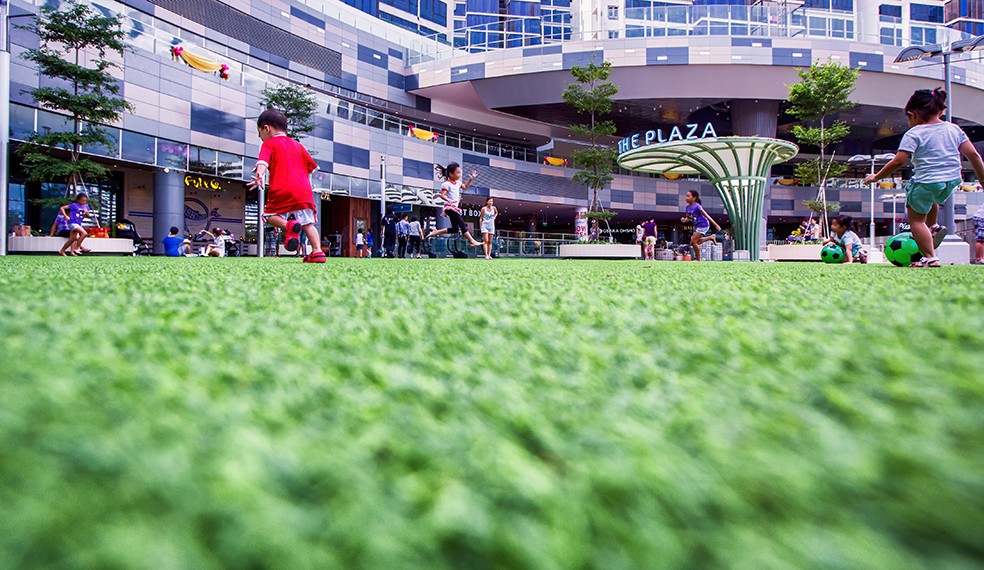Built to Last: How green malls and offices are creating healthier, more resilient spaces
As cities grow denser and the effects of climate change become more pronounced, the spaces we live, work, and play in need to do more than just serve our daily needs—they must support our well-being and stand the test of time.
From energy-efficient systems and solar panels to lush communal spaces that bring people closer to nature, these developments are redefining what it means to build for the future.
In our “Let’s Go Talk” series, Mr Kew Yuan Chun, Head of Sustainability & Safety at Frasers Property Singapore, shares insights into how green infrastructure is shaping healthier, more resilient environments for communities, businesses, and beyond.
Q: What is a climate-resilient infrastructure?
Climate-resilient infrastructure involves incorporating green features into existing buildings and new developments. These include energy-efficient equipment like LED fittings and cooling systems, as well as solar panels, like those that we have installed at some of our properties. So this reduces reliance on non-renewable sources, improving the energy efficiency and reducing carbon emissions.
Q: Why are such infrastructures important? Who does it benefit?
Green spaces are integral to Singapore’s identity as a “City in a Garden.” In our dense urban environment, they improve air quality, support biodiversity, and promote physical and mental well-being. This holistic approach to sustainability benefits businesses, our people, our communities, and living areas, creating a positive environmental impact for everyone, including shoppers and residents.
Q: We understand Waterway Point is a certified green building. How do green building features benefit shoppers and visitors to the mall?
Waterway Point is one of the largest suburban malls in Singapore and has achieved Green Mark GoldPLUS certification. The mall features energy-efficient equipment that also improves the air quality, supports biodiversity and promotes the health and well-being of shoppers and tenants.
In Waterway Point, we have green spaces that foster more social interactions where families can come to enjoy fresh air. The mall also has high-efficiency LED lighting, smart car park systems, and high-efficiency cooling systems that reduce energy consumption and the overall carbon footprint.
The Plaza at Waterway Point provides a green space for communal events.
Q: How do green spaces impact businesses and employees?
Introducing green spaces are part of our overall strategy to enhance green buildings. So when we have green buildings, that means they are certified and we have satisfied most of the requirements under the Green Mark, which includes the efficiency of the buildings, environment and having green spaces.
For example, we have Alexandra Point, which has recently undergone asset enhancement works. The refurbished building has an upgraded green corridor connected to the surrounding nature, which helps the building’s occupiers connect to the outdoors.
For Frasers Towers, we incorporate features like the energy-efficient equipment and green spaces that improve our tenants’ connection to the outdoors and improve both their morale and productivity, in addition to their health and well-being.
Q: What initiatives are in place to enhance the sustainability of developments by Frasers Property Singapore?
The built environment accounts for nearly 40% of the global carbon emissions. By aligning with Frasers Property Group’s benchmark and collaborating with our stakeholders, we leverage our position in the value chain to reduce carbon emissions together as we progress towards a low-carbon future.
At Frasers Property, we have in place a Group Responsible Sourcing policy and Corporate Functions Procurement procedures to influence the sustainability practices of our suppliers, vendors and contractors. This supports resilient supply chains and aligns with our strategies to address climate change and reduce carbon emissions across Scopes 1, 2 and 3.
For instance, we work with solutions providers to embark on several initiatives, such as Singapore’s first food waste valorisation programme for retail tenants and Singapore’s largest single roll-out of solar panels at our retail and commercial properties. We also have high-efficiency chiller plants at Tampines 1 and Century Square that serve as two of three injection nodes in Singapore’s first brownfield district cooling project in Tampines. The network will generate chilled water for the malls’ cooling needs and also for the surrounding buildings within this district.
All these initiatives are collective and innovative efforts to tackle the sustainability challenges and drive greater energy efficiencies to reduce the overall carbon footprint.
Q: How else does Frasers Property work with partners and tenants in shaping green buildings?
One of the major components of our Net-Zero Carbon Roadmap is on reducing our Scope 3 carbon emissions, which involve our external stakeholders, including the tenants and services providers.
For tenants, one of the main parts will be their energy consumption. To reduce this, besides the responsible sourcing policy and procurement procedures, we have also included in our green leases some suggested sustainable initiatives that tenants can adopt such as lighting requirements that align with the industry’s code of practice.
For example, jewellery stores tend to have brighter storefronts but at the back-of-house areas they will use lower lux levels to ensure the overall lighting average meets code requirements.





